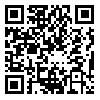Volume 3, Issue 9 (10-2013)
2013, 3(9): 15-27 |
Back to browse issues page
Radiation Absorption and Use Efficiency in Additive Intercropping of Maize and Bean in Zanjan Region
Dept. of Agron., College of Agric., Ferdowsi Univ. of Mashhad, Mashhad, Iran. , roholla18@gmail.com
Abstract: (7440 Views)
Improvement of resource use efficiency is a basic approach for sustainable agriculture. Applying intercropping systems, in which resources such as water, radiation and nutrients are used optimally, is one of these strategies. In order to evaluate radiation absorption and use efficiency in additive intercropping of maize-bean, an experiment was carried out in 2010, based on completely randomized blocks design with three replications, at Research Farm of Zanjan University. Treatments included different ratios of additive intercropping system (sowing 20, 40, 60 and 80% of common bean optimum density + optimum density of maize) and monoculture of these crops. Dry matter and leaf area of both crops were measured during the growth period. Results showed that the absorbed radiation by canopy of maize-bean intercropping in all treatments was higher than the monoculture of maize and bean, because the surface of canopy increases to absorb radiation. for intercropping system and result in more absorption of radiation compared to monoculture. The values of LERPAR were more than 1 in all intercropping treatments, which indicates the advantage of intercropping cultivation in comparison with monoculture system based on radiation absorption. Higher values of radiation use efficiency for maize and bean under intercropping system in comparison with monoculture of these crops confirmed the optimum use of radiation resource in intercropping system. Regarding the efficiency of radiation absorption by different intercropping treatments, the additive cultivation of 60% bean with 100% maize was identified as the best cropping pattern.
Type of Study: Applicable |
Subject:
General
| Rights and permissions | |
 | This work is licensed under a Creative Commons Attribution-NonCommercial 4.0 International License. |



